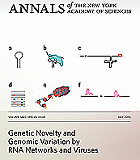 |
|
|
Article ID: 10 |
Audience: Default |
Version 1.00.01
| 2008/12/27 10:10:00 |
Reads: 3085
To know the “molecular syntax” (Manfred Eigen) of the genetic sequences of organisms doesn’t mean to know all “multiple protein meanings” (Gil Ast) that derive from a great variety of higher-order regulatory functions hidden in the non-protein-coding DNA. The network of higher-order regulatory functions and its important role to the key processes in DNA replication and recombination is now being recognized as a complex hierarchical pattern. This includes also the highly dynamic patterns of genome formatting as prerequisite to the great variety of epigenetic processes as demonstrated by Randy Jirtle at the Biosemiotic Congress 2006 in Salzburg.
The whole toolbox of “natural genetic engineering” (James Shapiro) apparently involves complex interactional networks of text-editing competences. Interestingly, recent research on the important roles of viruses in the evolution of life (Luis Villarreal) has now provided strong evidence that all key features of natural genetic engineering have been derived through different life-strategies of viruses throughout the history of evolution.
|
Select a topic:
|
|||||||||||||||||||||||




 Phages represent the most diverse inhabitants on this planet. Until today they are completely underestimated in their number, skills and competences and still remain the dark matter of biology
Phages represent the most diverse inhabitants on this planet. Until today they are completely underestimated in their number, skills and competences and still remain the dark matter of biology Genetic Novelty / Genomic Variations by RNA Networks and Viruses
Genetic Novelty / Genomic Variations by RNA Networks and Viruses
 Memory and Learning in Plants
Memory and Learning in Plants
 Biocommunication of Ciliates
Biocommunication of Ciliates Biocommunication of Animals
Biocommunication of Animals
 Biocommunication of Fungi
Biocommunication of Fungi Viruses - Essential Agents of Life
Viruses - Essential Agents of Life "Plants assess their surroundings, estimate how much energy they need for particular goals, and then realise the optimum variant. They take measures to control certain environmental resources. They perceive themselves and can distinguish between ‘self ’ and ‘non-self ’."
"Plants assess their surroundings, estimate how much energy they need for particular goals, and then realise the optimum variant. They take measures to control certain environmental resources. They perceive themselves and can distinguish between ‘self ’ and ‘non-self ’." 


